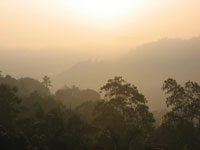
THE progress in tsunami reconstruction has caused an increase in tourist arrivals in Sri Lanka in the first quarter of 2006.
Arrivals numbered 159,664, according to media reports quoting the Sri Lanka Tourist Board (SLTB). Further business will be helped by a 70-million-euro credit line from the European Investment Bank to rebuild small- and medium-sized industries affected by the 2004 killer tsunami.
The loan covers all nine districts hit by the December 2004 disaster, financing projects such as infrastructure, tourism, energy and telecommunications related sectors, said Julian Wilson, head of delegation, European Commission Sri Lanka and Maldives.
“Businesses outside tsunami areas, but whose turnover was affected by the disaster, also qualify under this special tsunami loan,” Wilson told reporters.
The tailor-made tsunami credit line for Sri Lanka can finance up to 75 percent of the cost of individual projects, with repayments spread over a five-year period.
“The challenge is to re-establish the local economy, maintain employment and create new job opportunities,” said Jean-Louis Biancarelli of the European Investment Bank. Sri Lanka’s Central Bank will pick up between 20-25 million euros of the credit line for its ongoing subsidies under a tsunami loan scheme while the balance will help shore up small- and medium-scale industries.
Wilson said the European Union had pledged over 200 million euros to Sri Lanka. The credit line, which forms part of the funds pledged, is in addition to around 130 million euros given earlier as grants.
Arrivals
The nearly 160,000 arrivals represent an increase of 27.5 per cent from 125,250 during the same period of 2005. Tourist arrivals in the first quarter of 2005 were affected by the tsunami.
The month of March 2006 alone saw 54,746 tourist arrivals, an increase of 8.6 per cent over the same month last year.
The statistics are based on package tourists and do not reflect tsunami aid workers from abroad, according to the Statistics Department of the SLTB. The majority of the package tourists were from Britain, followed by Germany. However, the highest number of people came in from India, due to discount airline packages.
In 2006, the tourist board expects a total of 600,000 arrivals. However, experts believe the recent upsurge in violence can affect the hospitality trade in the country.
Tourism is the country’s fourth-largest foreign exchange earner.
